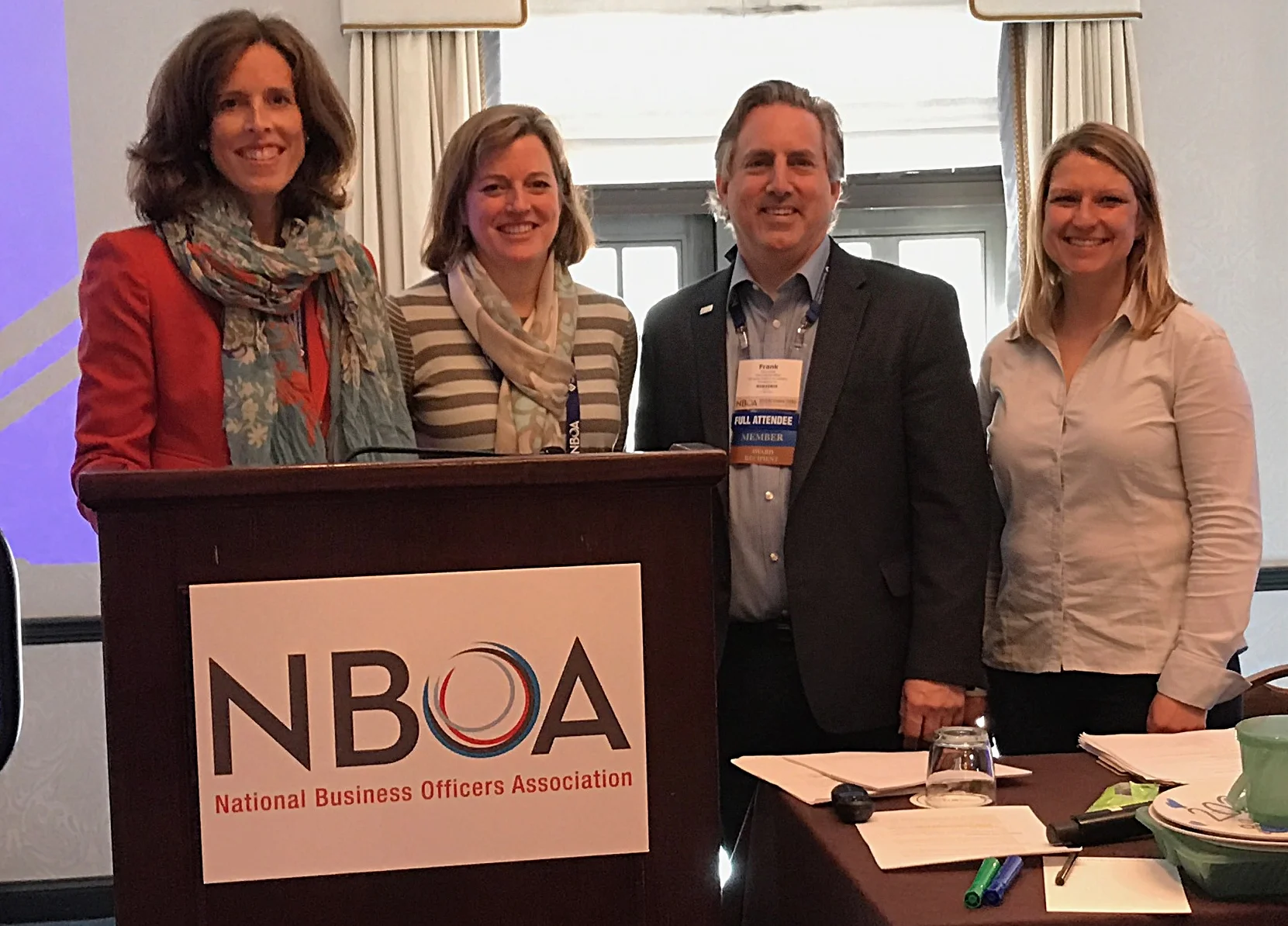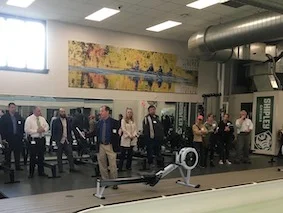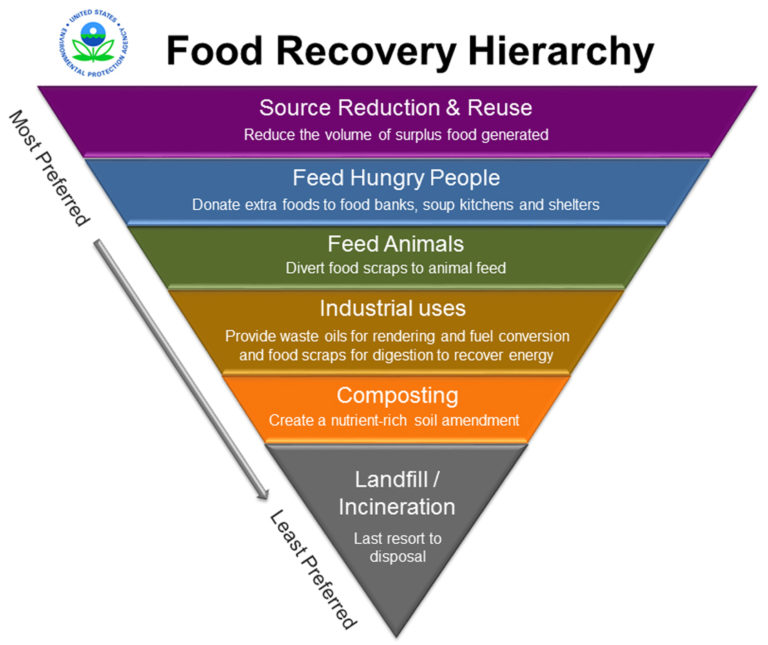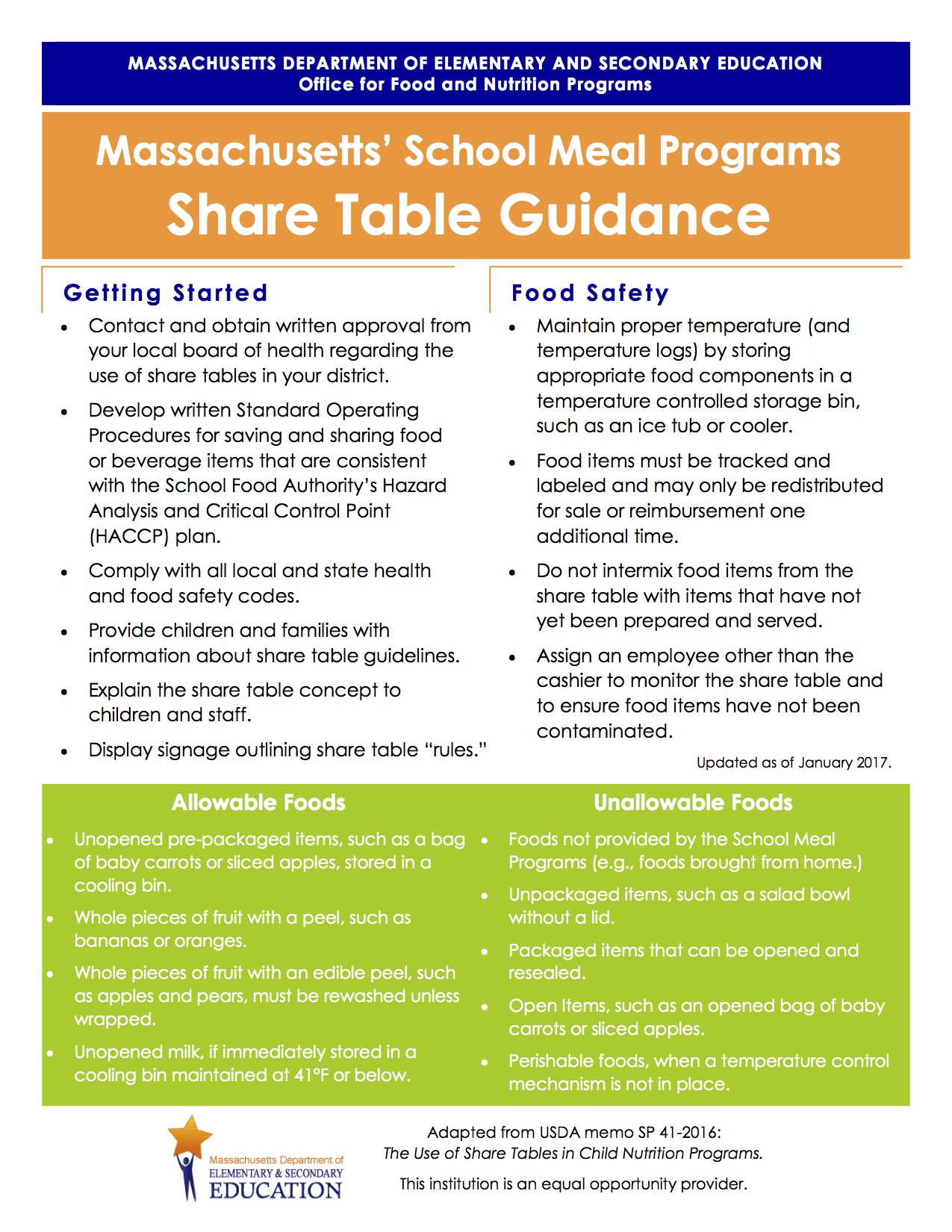On Wednesday April 30th, more than 30 educators, sustainability coordinators, and facilities staff from PAISBOA member schools came together for the group’s semiannual sustainability meeting, co-organized by PAISBOA and Boyer Sudduth Environmental Consultants (BSEC). This spring’s gathering was hosted by The Agnes Irwin School (AIS) and offered a space to share ideas, explore campus initiatives, and build connections around school sustainability.
From Ideas to Action: Students Present Sustainability Solutions to the School’s Administrative Team
At Abington Friends School (AFS), sustainability isn’t just a concept, it’s something that students are actively engaging with and exploring. Under the direction of Middle School science teacher Virginia Friedman, 7th-grade students took on a hands-on sustainability challenge: identifying areas where the school could reduce waste and become more environmentally responsible.
Sorting It Out: Abington Friends’ Waste Audit in Action
Did you know the average American produces nearly 5 pounds of waste per day (EPA, 2024)? Schools generate a significant amount of waste, from lunch trays to classroom materials, much of which could be diverted from landfills.
To better understand their impact, 7th Grade students at Abington Friends School conducted a waste audit, sorting and analyzing a school day’s worth of trash.
2022 Healthy Schools Summit: Recharging for a New Environmental Era
On December 9, 2022, educators, policymakers, scientists, and family members across the nation met virtually via Zoom to discuss the intersection of sustainability and education at Women for a Healthy Environment’s 2022 Healthy Schools Summit.
MFS’s Physical Plant Team Saves Money, Time & Energy
Moorestown Friends School has completed several green initiatives that both increase efficiency and save money. MFS’s Director of Physical Plant, Julius “Jul” Trimbach, offered some insight on how to transition a school into a more eco-friendly place.
Sustainability Group Meets at SCH Academy for Campus Tour, Plant-Based Dinner, & Electronic Waste
Over 20 participants from 11 schools attended the PAISBOA Sustainability meeting at Springside Chestnut Hill Academy on October 27, 2022. The theme for the evening: “Getting Back to Where We Were Before Covid” related to environmental sustainability.
Schools Re-imagine Outdoor Spaces
Studies show that being outside in nature has the ability to calm and heal. Spending as little as 15 minutes in nature lowers cortisol stress levels and blood pressure. Nature helps foster our creativity and observation skills. With the increase of screen time, we often forget to unplug and head outside.
Courtyard Renovation Sparks a Green Future for Reading High School
While the 2019-20 school year may have been an unconventional academic year for Reading High School (RHS), it has been a year of green changes. During this time, the school created plans to transform its overgrown and underused interior courtyard into a welcoming outdoor classroom and natural refuge. Students and teachers of a “green team” led these efforts. Their hard work paid off: RHS became the first school in Berks County, PA to become a certified National Wildlife Federation Eco School, achieving the bronze award for its “schoolyard habitat” improvements.
Tools for Moving Your Campus to 100% Clean Energy
Educational institutions are instrumental in accelerating the transition to clean energy. As centers of scholarship, innovation, and technical expertise, they are well-positioned to lead the charge towards sustainability. Here are tools educational institutions can use to transition to clean energy as outlined in Environment America’s fact sheets, which can be found at https://environmentamerica.org. While written with higher education institutions in mind, much of the report’s guidance is applicable to K-12 schools as well.
Climate Change: From Classrooms to Community -- Revisiting Climate Change Teacher Training
On Saturday, January 25th, 2020 a group of dedicated teachers braved rainy weather to attend a Philadelphia GreenFutures Climate Change Teacher Training Workshop at Fairmount Water Works. A partnership between environmentally focused organizations organized this event for Philadelphia School District teachers to discuss their progress following last summer’s three-day summer climate education workshop.
Aquaponics in the Classroom: PAISBOA Sustainability Group Visits Agnes Irwin School
The PAISBOA Sustainability Group convened at The Agnes Irwin School (AIS) on January 14th. Head of School, Dr. Wendy Hill, welcomed over 36 participants from 13 different institutions and highlighted how sustainability has been integrated into the buildings and classrooms at AIS along with a special focus on aquaponics.
Haverford College’s Green Initiatives: from Elevated Arboretum Status to Dining Hall Changes
Leading Sustainability by Catalyzing Cultural Change at The Shipley School
Over 40 participants from 19 schools attended the PAISBOA Sustainability meeting at The Shipley School on April 4, 2019. The theme: “Creating Cultural Change” towards sustainability. Key highlights included a tour of the School that featured sustainability measures in its operations and infrastructure, a delicious plant-based dinner, and a presentation on cultural change.
Teachers’ Bright Ideas About Energy Workshop
On March 16, 2019, Boyer Sudduth helped to run the Bright Ideas About Energy Workshop at the Franklin Institute. This workshop consisted of twenty-two sustainable minded teachers from the Philadelphia region seeking to enhance their understanding of energy conservation and develop tools to bring back to the classroom.
National Recognition Drives Excellence in Green Schools
Sharing Sustainability Success in Schools
Last year, the Arlington Public School District (APS) in Massachusetts was one of fifty-eight primary, secondary, and postsecondary schools and school districts to receive national recognition for efforts and achievements in sustainability. Over the course of several years APS invested in improving energy efficiencies by installing solar panels, new natural gas boilers, LED lighting, and energy management systems, among other operational improvements (APS ED-GRS application, 2017). Students and faculty can be found composting, diverting 122,000 pounds of food waste from the landfill each year. Students also have the opportunity to learn about environmental science, energy efficiency and sustainability through recycling and composting programs as well as interactive tools that display energy use and savings.
Through these diligent efforts APS was able to earn the U.S. Department of Education Green Ribbon Schools (ED-GRS) Award. Considered the top honor for green schools, DOE grants ED-GRS awards every year in conjunction Earth Day celebrations. The goal? Inspiration and resource-sharing. “The ED-GRS award was very meaningful,” says Arlington Public Schools Sustainability Coordinator, Rachel Oliveri, “it not only gave us state and national recognition but also led many other communities to reach out and learn from us and exchange ideas.” In a press release after receiving the 2018 award, Superintendent Kathleen Bodie said, “it’s such an honor to be cited on the national level for our efforts and to educate students who see themselves as powerful change makers.”
Developing minds are a distinct target for initiating change, promoting sustainable innovation, and spreading awareness. More than a quarter of the U.S. population is school-aged (0-25), most of whom spend significant portions of their day in educational institutions (and more, if you include faculty and staff) (KFF, 2016). Thus, educational institutions have become exemplars and boiling pots of sustainable transformation. Through efficiency improvements, recycling, composting and other waste-reduction programs along with numerous environmental education opportunities, schools across the country are taking steps (both big and little) towards a more sustainable future for generations to come. ED-GRS awards work as a catalyst to improve infrastructure, experience, and opportunity in schools nationwide by amplifying sustainability success stories and sharing best practices. Green schools “teach students how to lead a changing world, and they support student understanding by modeling sustainable behavior through green operations and building practices” (Center for Green Schools, 2018).
Every year each state can nominate up to six schools and/or districts for consideration by the U.S. Department of Education. Schools that qualify as “green” must demonstrate progress in three main areas, or “pillars” (U.S. Dept. of Education, 2018):
Pillar 1: Reduce environmental impacts and operational costs
Schools with more energy efficient operations spend less on utility costs and are better able to channel resources to education.
Pillar 2: Improve health and wellness
Schools with healthy environments allow students, faculty, and staff to flourish.
Pillar 3: Provide effective environmental and sustainability education
Schools that offer exceptional educational opportunities in hands-on cross-departmental environmental learning (especially STEM and green careers) foster student engagement, civic skills and leadership.
The program has “made a significant impact on the green schools movement,” says ED-GRS Director, Andrea Falken. The DOE now has “an unprecedented platform to address school facilities, health, and environment.” Falken believes in the program’s unique ability to foster collaboration. ED-GRS and it’s affiliated resource-sharing tools have worked to spread awareness of the many free programs that organizations such as NOAA, EPA, and U.S. Departments of Agriculture, Interior, and Energy offer. The program has also enabled collaborations across the for- and non-profit private sectors, Falken says.
While the award itself is strictly non-monetary, the program fosters a funding culture that values and strives for excellence in sustainability. Many states have adopted funding programs specific to sustainability improvement projects, such as Green Building United’s Delaware Pathways to Green Schools Program, which offers mini grants and other resources to promote sustainability improvements in schools. Other states have incorporated sustainability standards and requirements into their existing funding programs for capital improvement projects. In Massachusetts, the School Building Authority (MSBA), which provides funds for most major building projects, sets baseline sustainability standards and provides incentives for going beyond those standards (MSBA, 2011). Matthew Deninger, who works for the Massachusetts Department of Elementary and Secondary Education, serves on the MSBA board, and is the Massachusetts coordinator for ED-GRS, believes that the ED-GRS award program and MSBA funding requirements complement each other quite effectively. “The MSBA baseline standards are pretty high,” Deninger says, “so any school that does a major remodel or new construction project that is funded by MSBA is required to meet those standards. Schools can also opt-in to higher sustainability standards such as LEED-S or NE-CHIPS and gain additional reimbursement points.”
Massachusetts (and many other states) have also used the application process for ED-GRS awards as a means to recognize sustainability efforts big and small within their state. “Even if a school doesn’t quite make it to consideration on the national level, we recognize state finalists and sustained excellence at schools that have already been recognized in past years,” Deninger says. “There’s a tremendous amount of work happening by teachers and students who go above and beyond,” he says, “it’s the least we can do to recognize their efforts.”
Has your school made significant progress on its sustainability goals? If so, you may want to consider applying to be nominated by your state for the ED-GRS award. Application deadlines are approaching - be sure to allow plenty of time for this prestigious application process. Information for all states can be found here or you can follow the links for select states below:
Pennsylvania Department of Education ED-GRS application: education.pa.gov
Due January 4, 2019
Massachusetts Department of Education ED-GRS application: doe.mass.edu
Due January 11, 2019
Delaware Green Building United Green Schools Program: greenbuildingunited.org
Rolling application
Want to make improvements in the three pillar areas at your school? BSEC has experience empowering and guiding schools through the development and implementation of sustainability strategic plans and programs. Contact us for a free phone consult!
You can find more information on the national ED-GRS program here. DOE’s Green Strides platform also offers a user-friendly pool of resources, funding and collaboration opportunities. You can also contact your state ED-GRS coordinator for more information.
Article submitted by Avery Wolfe a recent graduate of Bates College and intern with Boyer Sudduth Environmental Consultants.
Turning Food Waste into Food Recovery at School
EPA’s Food Recovery Hierarchy
https://www.epa.gov/sustainable-management-food/food-recovery-hierarchy
In the United States, food waste is a growing problem. Currently, about 40 percent of food is thrown away without any effort to divert it from the landfill. By weight, 63 million tons of food are wasted in the US alone every year. Not only is this behavior a gross misuse of food, but growing, processing, and transporting food is a major draw on resources. Food waste alone consumes 21 percent of all freshwater, 21 percent of landfill volume, and 19 percent of cropland (ReFED, 2018). The energy the US wastes on discarded food in a year is about twice as much energy Switzerland uses in a year (Webber, 2010) . Meanwhile, one in seven Americans are food insecure, meaning they lack reliable access to affordable, nutritious food (USDA, 2017). Due to the scale of this problem, the EPA has created a Food Recovery Hierarchy, a comprehensive graphic that outlines preferred food recovery techniques, with feeding hungry people and source reduction being the best practices.
Of the $218 billion worth of food wasted every year in the US, $1.2 billion is from school lunches (Bloom, 2016). In a study of four Boston schools, 26.1% of the food budget was thrown away by middle school students annually, not including the extra food that was never served (Cohen, 2013). While school lunch waste makes up a fraction of the wasted food in the US, it is an imperative problem to address. The K-12 educational system is an incredibly important piece of the American society, for it shapes the minds of its young generations. What these students learn in school can develop their passions, their habits, and their understanding of the world-- including the problems it faces. Allowing such waste in the school system teaches children that food is garbage, disposable and of little value. The USDA has introduced the Food Waste Challenge, a food waste reduction challenge for schools to participate in. Some schools have taken major steps towards reducing food waste and making students apart of the process so they can continue the legacy.
How You Can Have a Role in Change
Addressing food waste is a new and growing issue, but school administration can often be too busy to tackle the problem. So, it is often up to inspired community members to spark the change they would like to see. Wellesley, Massachusetts has an exemplary food waste reduction system, with programs including food share tables in elementary schools and a food donation system. These food recovery efforts began with a few concerned parents, teachers, and a motivated Food Service Director. From that grassroots beginning, food recovery projects have sprouted up in all K-12 schools in the Wellesley school district.
In the elementary schools, one parent took a special interest in food waste and was able to spark interest amongst fellow parents. With the help of custodians and the Bates Elementary School principal, they began looking into how to reduce consumer waste with their young students. To start, an experiment was conducted to discover what exactly was being thrown away by examining their waste. After this initial waste audit, Matt Delaney, the school’s Food Service Director from Whitsons Culinary Group, jumped on board. Three important steps were then taken:
Food services cut back on the food that was not being sold.
Kitchen staff went through a training process on how to package food eligible for donation.
Food that was not being sold or even put out was packaged up and taken by volunteers to food pantries.
Today, excess prepared food is frozen and then picked up by Food for Free, a food rescue organization, every two weeks and taken to nonprofits in need of food. Since then, Mr. Delaney has made great efforts to tailor meals and portions so that food waste is minimized. Future goals include expanding the school’s reusable “green” food container supply and introducing food waste composting to all cafeterias.
Green Containers used by Wellesley Public Schools. Source: Matt Delaney, Whitsons Culinary Group
After learning that the school was throwing away edible food in the initial student led waste audit, Bates Elementary School began a “share table.” Share tables (often found in elementary schools) are areas where students can leave their unopened food so that it can be redistributed. At Bates, students leave their unopened food on a specific table after lunch so it can be redirected to students in the after school program, teachers, and town departments such as Public Works. The program has been expanded to a few other Wellesley elementary schools.
In Wellesley elementary schools, parents and the Food Service Director played key roles in inspiring and implementing the food rescue program. A hope for the future in middle and high schools is that students may be inspired to address food waste and go beyond food donations and share tables. For example, students can examine why it is important to conserve food and understand the causes of the food waste challenge in the United States. In 2015, the U.S. Environmental Protection Agency set a goal of reducing food waste by half by 2030 (EPA, 2015). Consumer education will be a big part of reaching this goal. At schools, students can learn strategies for prevention, recovery and recycling of food waste. From “right sizing” portions to properly disposing of plate waste or “leftovers,” lessons about reducing and managing food waste. While curriculum is often slow to change, teachers who want to teach about food waste can work with motivated students to take the initiative to educate themselves and their peers. The links below offer some helpful suggestions for getting started.
In colleges, students often make this push. An organization called the Post Landfill Action Network (PLAN) provides resources to college students who are seeking guidance in changing the food systems at their schools. Campus Coordinators work with individual students or environmental student groups to implement waste reduction techniques such as changing portion sizes, removing trays, implementing compost, and donating unserved food. Even these students have trouble making change in consumer behavior, possibly because older students are more prone to sticking to habits. If behavioral change can be introduced at younger ages, there’s far more potential for lasting differences in how people consume their food.
How to Start Food Sharing and Donations at Your School
Massachusetts Department of Elementary and Secondary Education Guide to Share Tables https://thegreenteam.org/wp-content/uploads/2014/04/Share-Table-Guidance.pdf
Fortunately, the Federal Government protects donors of food through the Bill Emerson Good Samaritan Food Donation Act of 1996, which encourages donations of food and grocery products to nonprofit organizations. The Act encourages donations by stating that legally, a person shall or gleaner not be subject to civil or criminal liability arising from the nature, age, packaging, or condition of apparently wholesome food or an apparently fit grocery product that the person or gleaner donates in good faith to a nonprofit organization for ultimate distribution to needy individuals” (US Cong. 104-201). Although the federal government may encourage food donations, each state and school district has different policies as to how share tables and food donations should function, if they are allowed at all. The website Food Rescue has a history of State Policy on food waste in schools, which is important to know when attempting to start a share table of your own. Some schools donate unserved prepared food by donating it to a food rescue that will distribute it to a nonprofit serving those need. Once state and local allowance is confirmed, local board of health approval is also necessary.
Other key players to work with are the food service department, custodians, and administration. Food sharing, donating, and conservation cannot be done without the help of these departments who monitor different aspects food services. Creating collaborative relationships with these people are required to the functioning of any food rescue, share, or compost operation.
Thank you Matt Delaney of Whitsons Culinary Group, Phyllis Theermann of Sustainable Wellesley, and Adina Spertus of Post Landfill Action Network (PLAN).
Written by Meggie Devlin, Intern, Boyer Sudduth Environmental Consultants LLC.
August 7, 2018
Resources for Minimizing Food Waste at your School
Federal Guidelines on the Good Samaritan Act:
Bill Emerson Good Samaritan Food Donation Act of 1996
LL.M Program in Agricultural & Food Law at the University of Arkansas Legal Guide to Food Recovery Laws:
https://law.uark.edu/documents/2013/06/Legal-Guide-To-Food-Recovery.pdf
ReFED Guide to State Laws on Food Recovery
https://www.refed.com/tools/food-waste-policy-finder/
Guide to State Laws on Food Rescue in Schools
http://www.foodrescue.net/school-food-waste-policy-history.html
REFERENCES
Bloom, J. (2016). Schooling Food Waste: How Schools Can Teach Kids to Value Food. Retrieved August 7, 2018, from Food Tank website: https://foodtank.com/news/2016/11/schooling-foo d-waste-how-schools-can-teach-kids-to-value-food/
Cohen, J., Richardson, S., Austin, S., Economos, C., & Rimm, E. (2013). School lunch waste among middle school students: nutrients consumed and costs. PubMed, 44(2).
Cuellar, A., Webber, E. (2010). Wasted Food, Wasted Energy: The Embedded Energy in Food Waste in the United States. Environmental Science & Technology. 2010 44 (16), 6464-6469.
Food Security in the US: Measurement. (2017, October 4). In USDA: Economic Research Service. Retrieved August 7, 2018, from https://www.ers.usda.gov/topics/food-nutrition-assistance/food-security-in-the-us/measurement/
The Multi-Billion Dollar Food Waste Problem. (2018). Retrieved August 7, 2018, from ReFED website:https://www.refed.com/?sort=economic-value-per-ton
United States, Congress, Senate. Bill Emerson Good Samaritan Food Donation Act. Government Printing Office, 1996. 104th Congress, Senate Bill 104-210.
United States 2030 Food Loss and Waste Reduction Goal. (2015). In United States EPA. Retrieved from https://www.epa.gov/sustainable-management-food/United-states-2030-food-loss-and- waste-reduction-goaf
Freight Farming on Campus
Photo: Students at Boston Latin stand outside of their Freight Farm
Stepping into the shipping container on the grounds of Boston Latin School is not what you would expect. The glow of LED lights, the cool humid temperature and the abundance of leafy greens hanging from the ceilings might surprise you, but for the students in charge of maintaining this wonder, it’s just another day.
Shipley Links Compassion to Sustainability
Three strikes, LIGHTS OUT!!
It can be difficult to find ways to engage students in environmental sustainability projects, but adding some friendly competition can go a long way. The Fenn School in Concord, Massachusetts is using America’s favorite past-time, baseball, to encourage their students to be more conscious of electricity use.


























